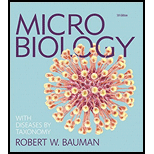
Concept explainers
In which type of symbiosis do both members benefit from their interaction?
- a. mutualism
- b.
parasitism - c. commensalism
- d. pathogenesis
Introduction:
Symbiosis is a process that provides a close relationship between two species where both the species share common habitat. Members that take part in symbiotic relationships are called “symbionts”.
Answer to Problem 1MC
Correct answer:
Mutualism is a type of symbiosis in which both members benefit from their interaction. Therefore, option (a) is correct.
Option (a) is given as “mutualism”.
Explanation of Solution
Justify reasons for the correct statement:
The symbiotic relationship that benefits both the members is termed as mutualism. Mutualism improves the fitness of both members. For example: Bacteria that live in the colon of human receives a moist, warm and nutrient-rich environment in which it can proliferate and human absorb vitamin precursors along with other nutrients from bacteria.
Hence, option (a) is correct.
Justify reasons for the incorrect statements:
Option (b) is given as “parasitism”.
In this relationship, one member or species get resources at the cost of a living host. Hence, it is a wrong answer.
Option (c) is given “commensalism”.
In this relationship, one member is benefitted while other remains unaffected significantly. Hence, it is a wrong answer.
Option (d) is given as “pathogenesis”.
Pathogenesis is an event in which an infection occurs in the host’s body. Hence, it is a wrong answer.
Hence, options (b), (c) and (d) are incorrect.
In mutualism, both the species are benefitted with the presence of one another.
Want to see more full solutions like this?
Chapter 14 Solutions
Microbiology with Diseases by Taxonomy - With Access
- where do pathogens do not thrive and reproduce? a. human beings b, animals c. inaminate objects d. wallarrow_forwardHow is the Zika virus spread? A. Through person-to-person contact B. Through mosquito bites C. Through dog bites D. Through the release of the virus into the air by plantsarrow_forwardWhat kind of relationship is shown by a thick feeding on human blood? a.)competition b.)commensalism c.)mutualism d.)parasitismarrow_forward
- What are symbiotic organism give an example to explain symbiosis among organismarrow_forwardResearch The Zika outbreak in Brazil: Then provide identification of the health issues and concerns that arose from the incident/disasterarrow_forwardwhat is the most dangerous disease that has no curearrow_forward
- Offer an opinion of what is the most devastating human disease and give a reason for the choice?arrow_forwardMalaria is a disease in humans caused by infection with a protist, a eukaryotic organism. What describes the interaction between humans and the organism causing malaria? 1.Predation2. Parasitism3. Commensalism4. Mutualismarrow_forwardIf a fisherman went out to try and catch anchovies, what would be an example of bycatch?arrow_forward
- Write a short essay that summarizes the circumstances in which gram-negative bacteria are involved in opportunistic infections.arrow_forwardParasitism isarrow_forwardShort answers only. Discuss the Life cycle of the following parasites: a. Dracunculus medinensis b. Capillaria philippinensisarrow_forward
 Concepts of BiologyBiologyISBN:9781938168116Author:Samantha Fowler, Rebecca Roush, James WisePublisher:OpenStax College
Concepts of BiologyBiologyISBN:9781938168116Author:Samantha Fowler, Rebecca Roush, James WisePublisher:OpenStax College
- Essentials Health Info Management Principles/Prac...Health & NutritionISBN:9780357191651Author:BowiePublisher:Cengage
 Comprehensive Medical Assisting: Administrative a...NursingISBN:9781305964792Author:Wilburta Q. Lindh, Carol D. Tamparo, Barbara M. Dahl, Julie Morris, Cindy CorreaPublisher:Cengage Learning
Comprehensive Medical Assisting: Administrative a...NursingISBN:9781305964792Author:Wilburta Q. Lindh, Carol D. Tamparo, Barbara M. Dahl, Julie Morris, Cindy CorreaPublisher:Cengage Learning





